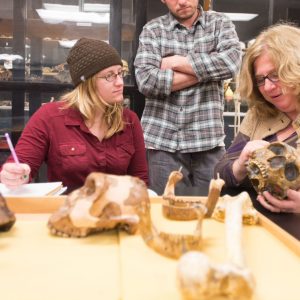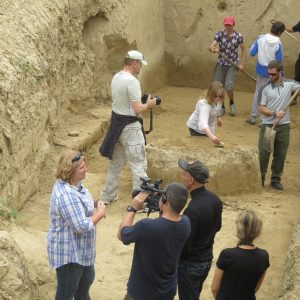End of an Era
After more than a decade as department chair, Professor Mica Glantz leaves a legacy of growth and adaptation
September 2024
Josh Zaffos

The fields of anthropology and geography are, essentially, studies in adaptation and change. So, it’s no surprise that Professor Mica Glantz encountered and embraced plenty of departmental evolution and transformation as chair of Colorado State Anthropology and Geography.
During two-plus terms and 11 years, Glantz, a biological anthropologist who concluded her time as chair in Summer 2024, oversaw significant growth and change across the department. In that time, the unit expanded its name and focus to Anthropology and Geography, added a new doctoral program, majors, minors, a certificate, an online bachelor’s degree, and several new field schools and abroad classes. Faculty and staff positions have increased, research centers and labs have grown, and the department is a few years away from being located in a revitalized Clark Building.
“Anthropology and geography have always been disciplines in progress and are constantly in revision,” Glantz said. “We need to think critically about how we show up in the world and show the value of our scholarship, and we can’t get complacent about that. All our new programs are ways that we are meeting the moment, encouraging student engagement, and setting a course for our scholarship to address the challenges of future.”
Settling In and Launching the Online BA

Glantz landed in the chair’s office for the Department of Anthropology in 2013 when then Chair Kathleen Pickering was promoted to a Vice Provost position. Pickering and others identified Glantz as the person to take over in an interim role and offered her the position – while she was afield in Kazakhstan excavating at Neandertal archaeological sites. It was a different kind of foreboding experience than digging in a cave looking for evidence of early human life and activities but Glantz was ready for the moment.
“I’m an extrovert, so the upshot of being chair has been getting to know and speak to people in our communities, our students and alumni,” Glantz said, “and that has always felt good.”
“Kathy [Pickering] was exceptionally strategic and smart and left a vision for the department, so I got to continue the process on a few things,” Glantz recalled.
At the time, CSU Anthropology was already offering online classes, but Glantz took up the initiative to build out and launch an online Anthropology Bachelor of Arts degree with CSU Online.
“As a department, we take the land-grant mission seriously, so the online Anthropology BA is all about access for students who cannot be on campus,” Glantz said. “It was exciting to develop these virtual experiences and classes. It felt like new and exciting territory.”
The program’s success and revenues have bolstered the department at large, supporting increased faculty and staff positions and other department activities.
A Department Evolving

When Glantz decided to run for her first full term as chair, her vision centered on opportunities for department growth and starting a doctoral program.
“We’ve had a historically strong Anthropology Master’s program and great success placing graduate students in jobs,” Glantz said, “but we also recognized that, in some ways, our students’ research and projects looked more like Ph.Ds.” Except that wasn’t an option for study at CSU.
Glantz led the effort to create the doctoral program built around the department’s interdisciplinary strengths between anthropology and geography. The doctoral program’s focus on Space, Place, and Adaptation is unique and has drawn a diverse pool of students since opening in 2018.
“We have an exceptional constellation of scholars in anthropology and geography and our Ph.D program has really helped us integrate geography and to support students to move ahead in industry and academia,” Glantz said. “People in our program are honing skills and getting jobs. We have also really seen the benefit of graduate students and faculty working together in the field, classrooms, and labs.”
The department also expanded its name to include Anthropology – and Geography – in 2018, elevating the program to create CSU’s first Geography bachelor of science program and new minors that allow students to gain knowledge and skills in geographic information systems (GIS) and spatial analysis.
Bringing On a Department Growth Spurt
Anthropology and Geography has kept up with changes by adding faculty who have started up new labs and research centers and led field and outreach activities.
“We’ve done tremendous hiring in the last ten years to grow the department, and I’m incredibly proud of the scholarship coming out of here,” Glantz said.
“Mica was very effective at obtaining resources for our department, particularly in her continuous advocacy for new faculty hires over her tenure as chair,” added Lynn Kwiatkowski, Professor of Cultural Anthropology.
Glantz and faculty have also upheld Anthropology and Geography’s dedication to field experience and hands-on learning as the department has grown. Since 2013, the department has added an annual Primate Paleontology Field School that brings students to find and study fossils in Wyoming each summer. Faculty have also continued the long-running Archaeology Field School, run several Ethnographic Field Schools, and created several study-abroad field classes and programs. Glantz also backed the creation of a new undergraduate Museum and Cultural Heritage Studies Certificate.
“Having a museum studies program allows us to interpret, present, manage, and protect cultural heritage – it is such a critical piece of our curriculum – providing students with real-world experience here within our program,” said Jason LaBelle professor of archaeology and curator of the CSU Archaeological Repository. “It is also ethically sound – the collections have received a significant amount of attention, organization, and re-housing since we started this program – and this care comes from the students themselves and supported by grants from the Colorado State Historical Fund as well as the Bureau of Land Management.”
“Undergraduates come into our department and want to get their hands on materials, and we’re fortunate to have materials and programs on top of our institutional wealth and our resources,” Glantz added. “Museum Studies and field schools connect a lot of threads for our department, and we know there are jobs” for students who pursue those opportunities.
We need to think critically about how we show up in the world and show the value of our scholarship, and we can’t get complacent about that. All our new programs are ways that we are meeting the moment, encouraging student engagement, and setting a course for our scholarship to address the challenges of future.
Enduring COVID and Reimagining Clark
Glantz’s second full term as chair, beginning in 2019, was one of unexpected challenges and opportunities – including the COVID pandemic and the Clark Building revitalization.
“Mica skillfully shepherded the faculty, staff, and students of our department through the uncertain and novel period of COVID with grace and a calm and witty demeanor,” Kwiatkowski said. “Her leadership during that precarious time enabled us to carry out our work with confidence.”
“That was the most intense work period I’ve ever had in my life,” recalled Glantz, who also served as interim chair for the Department of Ethnic Studies during the first years of the pandemic. “I think we did the absolute best we could do to maximize in-person classes – measuring seat spacing and doing all the things we had to do to show up for students. We offered field schools” – both virtual and in the field with masks and other precautions – “and we just kept moving to meet the moment.”
That’s also meant taking an engaged role in planning for the renovation of the Clark Building, which began in 2021. As a department with labs, offices, and classrooms spread across all three wings of Clark, Anthropology and Geography is uniquely – and substantively – impacted by the building construction. (Department faculty and graduate students moved and relocated from Clark throughout 2023.)
But the state- and CSU-funded building revitalization comes along at a opportune moment for a department that has evolved in many ways since Glantz began as chair. Glantz and faculty and staff have actively participated in design meetings to advocate for the department to have public-facing repository and collections spaces and labs for department faculty and students.
“One of the things I’m most proud of is our work and involvement with the Clark Building revitalization, and how we’re positioned to be visible in the new building,” Glantz said. “If we can see that vision through, we expect Anthropology and Geography to showcase something that students are excited about.”
Looking Beyond

While serving as chair, Glantz won the College of Liberal Arts Outstanding Service Award and the Center for Women’s Studies and Gender Research’s Margaret B. Hazaleus Award, both recognizing her commitments and involvement to students and the university. Glantz served as interim chair for the Department of Ethnic Studies from 2019-2022 and has been a co-chair and leader of the CSU Advisory Council for Jewish Inclusion since its inception as a task force, among her participation in numerous other university committees and projects.
“Mica brought an ability to focus on big issues and to bring folks together to work on those issues,” LaBelle said. “She has been an advocate for us all, and brought vision and tenacity.”
Glantz is taking a deserved break and sabbatical in the 2024-25 academic year but is energized to get back to her research and writing after mostly stepping away from projects as chair and to return to teaching. She is also excited for Professor Michael Pante, the new department chair, and to support Anthropology and Geography as it will continue to grow and evolve in the coming years.
Department Accomplishments and Highlights under Chair Mica Glantz
* Launch of new doctoral program dedicated to Space, Place & Adaptation
* Renamed department and increased number of tenure and nontenure faculty
* Created Geography B.S. major
* Launch of Paleontology Field School
* New minors
* Launch of Museum & Cultural Heritage Studies Certificate
* New faculty labs and research centers
* Created Online Anthropology B.A.
* New study abroad courses and programs
* Expanded student scholarships
* Launch of Trunk Show outreach program